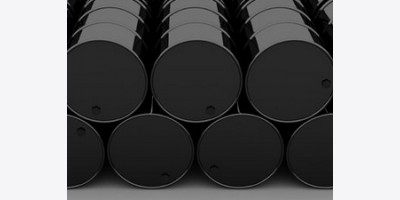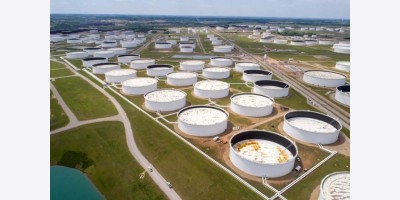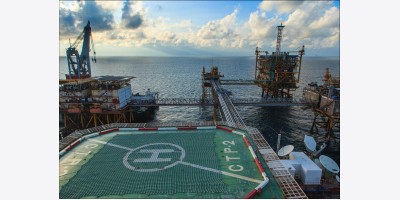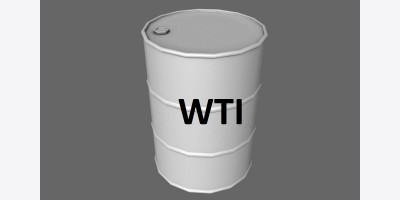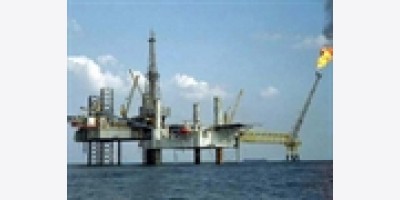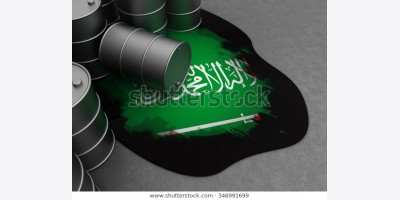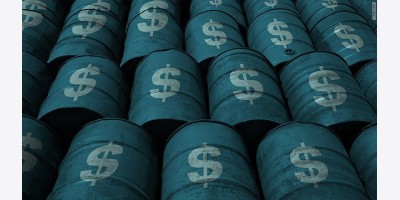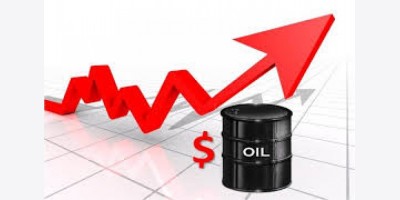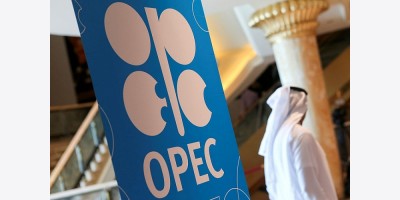By Sebastian Boyd Jul 1, 2014 6:12 PM GMT+0700
Venezuelan bonds are posting the world’s best returns after a surge in the price of oil, the country’s biggest export. Goldman Sachs Group Inc. and Morgan Stanley say buyers are unwise to bet $115-a-barrel crude can fix a broken economy.
The government’s dollar-denominated notes have gained 5.9 percent since rebels took over swaths of northern Iraq on June 11, stoking concern that crude production will be hurt and pushing Brent oil prices over $115 for the first time since September. While the return was more than 14 times the average for emerging-market debt, the extra yield of 8.63 percentage points that investors demand to own Venezuela’s bonds instead of U.S. Treasuries is still the highest in the world.
Any extra cash generated by the OPEC member’s oil exports is likely to be siphoned off to pay for imports of consumer goods amid shortages of drinking water, toilet paper and medicine that have sparked anti-government protests, according to Daniel Volberg, an economist at Morgan Stanley in New York. After currency devaluations and energy output declines, President Nicolas Maduro is struggling to prop up an economy posting the world’s fastest inflation and facing the worst growth prospects outside Equatorial Guinea, according to the International Monetary Fund.
“The level of macroeconomic dysfunction is so deep that the story really isn’t about oil prices anymore,” said Alberto Ramos, the chief Latin American economist at Goldman Sachs in New York. “Unless policies change dramatically, I’d be concerned even with the oil price at $150.”
Currency Controls
Since Maduro succeeded his mentor, the late Hugo Chavez, in March 2013, the economy’s stagnation has deepened as currency controls impeded imports and factories shut down. The number of cars built in Venezuela fell 77 percent in the first five months of this year as automakers including Ford Motor Co. and Toyota Motor Corp. froze production while American Airlines Inc. (AAL) and Air Canada have cut back flights to the country because of difficulty getting money out.
Still, the nation has kept paying its debt.
Venezuelan dollar bonds have returned 19 percent this year, the best performance among developing countries, as suppressed interest rates in the U.S. and Europe boosted demand for higher-yielding assets. The average yield on Venezuela’s dollar debt is the highest in the world at 11.16 percent, 0.8 percentage point more than lower-rated Argentina, which faces default as soon as July 30.
Bank Meetings
Venezuela will continue to meet its obligations, Rafael Ramirez, the economy vice president, said June 27. Officials are meeting representatives of Bank of America Corp. Citigroup Inc., Credit Suisse AG, Deutsche Bank AG and Goldman Sachs in Caracas to discuss debt, Ramirez said.
Venezuela’s Finance Ministry didn’t respond to e-mail messages sent yesterday seeking comment on the government’s debt-payment policies.
Drew Benson, a spokesman for Credit Suisse in New York declined to comment, as did Kerrie McHugh, a spokeswoman for Deutsche Bank in New York. Press officers at Bank of America, Citigroup and Goldman Sachs didn’t respond to requests for comment.
Economic Fundamentals
This year’s rally in the bonds doesn’t “make sense given the direction fundamentals are going in Venezuela,” Volberg said.
The country’s international reserves fell 18 percent in the last 12 months to $21 billion on June 27. Arrears to importers and their banks may be worth as much as half the central bank’s reported reserves, Volberg said.
Annual inflation reached 61 percent in May after the government carried out its biggest devaluation since the introduction of currency controls in 2003. The economy will probably contract this year and next by as much as 1 percent, according to the IMF.
While higher oil provides some benefits, signs that Maduro is turning toward more pragmatic policies after four months of unrest across the country may be more encouraging to investors, according to Bank of America.
Last month Maduro fired Planning Minister Jorge Giordani, a long-term advocate of currency controls who taught Chavez economics in jail in the early 1990s. The country plans to merge its three official foreign exchange rates, Ramirez told investors in London in June.
Exchange Rate
The rates range from 6.3 bolivars per dollar to 50 bolivars per dollar. On the black market, the bolivar trades at 72.18 per dollar. The government is likely to unify exchange rates at about 25 per dollar, according to Bank of America.
The cost to the government of exchanging its oil dollars for bolivars at the official rate is the equivalent of 10 percent of gross domestic product, and authorities make that up by printing money, according to Francisco Rodriguez, an economist at Bank of America in New York.
“Venezuela has a source of revenue it can use and with unification it would pretty much solve its fiscal problem,” Rodriguez said by phone yesterday.
The country’s oil exports are falling as production wanes at state-run Petroleos de Venezuela SA. Oil sales declined 8.4 percent last year to $114 billion, the company said June 27. Output sank about 11,000 barrels a day in 2013 to a total of 2.9 million.
Technical indicators based on historical prices also indicate the Venezuelan bonds may have risen too far, too fast. The 14-day relative strength index on dollar bonds has been above 70 since June 19, indicating they’re the most overbought in two months.
“The question is how long the markets are willing to give Venezuela a free pass and how long this process can go on before you have a more disorderly adjustment,” Volberg said.
To contact the reporter on this story: Sebastian Boyd in Santiago at sboyd9@bloomberg.net
To contact the editors responsible for this story: Brendan Walsh at bwalsh8@bloomberg.net Bradley Keoun
By Rakteem Katakey and Debjit Chakraborty Jul 1, 2014 6:23 PM GMT+0700
A rally that has added $102 billion to the market value of Indian state-owned companies this year is helping Prime Minister Narendra Modi raise cash from asset sales as oil prices and a weak monsoon weigh on the exchequer.
The S&P BSE India Public Sector Undertakings index comprising stocks of 59 state-run companies including Oil & Natural Gas Corp. (ONGC), the nation’s biggest explorer, has surged 46 percent this year, the most since 2009. That is more than double the pace of gains in the benchmark S&P BSE Sensex (SENSEX), which touched a record high on June 11.
The rebound is fueling optimism Modi will meet a target of raising 800 billion rupees ($13.3 billion) from reducing the government’s stakes in these companies this financial year. The cash from the sales may offset any potential revenue loss from below-normal rain crimping farm income and demand even as a conflict in Iraq threatens to boost crude oil prices and trigger a clamor for more fuel subsidies.
“An atmosphere has been created to unlock the value of all of these huge state-run companies,” ONGC Chairman D.K. Sarraf said on the phone. “This is going to help public finances.”
Bharat Petroleum Corp. (BPCL), ONGC, Coal India and Oil India Ltd. (OINL), a state-run energy explorer, are among the five biggest gainers in the MSCI Emerging Market Energy Sector index this year, surpassing Chinese government-owned companies China Petroleum & Chemical Corp. and PetroChina Co.
Falling Short
The combined market capitalization of Indian state-run companies on June 9 reached $338 billion, the most since January 2011, according to data compiled by Bloomberg.
The previous Congress party-led government of Manmohan Singh missed its divestment target in at least the last four consecutive years. It planned to raise 400 billion rupees in the 12 months ended March 31, and managed a less-than-half 158.2 billion rupees, according to the Department of Disinvestment’s website. The Sensex rose 9 percent in 2013 and 26 percent in the previous year.
In contrast, the Modi administration will raise its target for the year ending March 31 by about 41 percent to more than 800 billion rupees, finance ministry officials with direct knowledge of the matter said last week.
Public Holding
Adding urgency to the sales is a June 19 ruling by the capital markets regulator, requiring state-owned companies to increase their public shareholding to at least 25 percent within three years. The government will have to cut its stake in 36 such companies to comply with the decision, Securities & Exchange Board of India Chairman U.K. Sinha said the same day.
Among these are Coal India Ltd., the world’s biggest producer of the fuel used in power generation, and NMDC Ltd. (NMDC), India’s biggest iron-ore miner. The government owns 90 percent of Coal India and 80 percent of NMDC.
Cabinet notes have been sent for approval regarding 10 percent stake sales in Container Corp. of India and NHPC Ltd. (NHPC), and a note is ready on divesting stake in Coal India and ONGC, two finance ministry officials said June 25. More are planned for Hindustan Zinc Ltd. (HZ) and Bharat Aluminium Co. The government will also sell a 5 percent stake in Rural Electrification Corp. (RECL) and may list Hindustan Aeronautics Ltd.
“If the government were to sell shares in these companies, it would get a lot of interest from both domestic and international investors,” said Vaibhav Sanghavi, managing director of Ambit Investment Advisors Pvt. in Mumbai, which manages about $150 million of assets. “The performances of state-run companies over the last half decade haven’t been good and that view may be changing with this government.”
Changing View
Sanghavi’s fund bought shares of some of state-run companies after the federal elections in May, he said. They didn’t own any state-run companies before that.
Modi was sworn in on May 26 after his Bharatiya Janata Party won the biggest victory margin seen by any single party in 30 years on a campaign of reducing inflation, creating jobs and reviving Asia’s third-biggest economy from near the slowest pace of growth in a decade.
India’s economy expanded 4.6 percent in the quarter ended March 31 versus China’s 7.4 percent. Amid threats of a sovereign rating downgrade to junk, former finance minister Palaniappan Chidambaram had projected a budget deficit of 4.1 percent of gross domestic product for the current fiscal year, narrower than the 4.5 percent a year earlier. Modi’s government is due to present its budget on July 10.
Capping Prices
Brent crude prices near a 10-month high may make Modi’s task difficult as the $1.8 trillion economy depends on oil from overseas to meet 80 percent of its needs. A persistent increase of 10 percent in crude oil prices may lead to about 100 basis points increase in inflation, according to rating company Credit Analysis and Research Ltd.
Governments in India, where the World Bank says about 70 percent of the population lives on less than $2 a day, have traditionally resorted to subsidies to help cap retail prices and shield the poor.
Selling fuels below cost caused a revenue loss of 1.4 trillion rupees to state refiners last year, of which 51 percent was borne by the federal government and the rest by explorers.
Signaling its resolve to take unpopular decisions and mend state finances, the government increased railway passenger and freight charges last month by as much as 14.2 percent.
“The advantage of having a government with a majority is hard and necessary economic steps can be taken,” Ambit’s Sanghavi said. “Modi is showing he’s going to focus on reducing subsidy and the fiscal deficit.”
Weak Monsoon
A deficit in rainfall combined with high oil prices may undermine economic recovery, and the government should use the money raised from stake sales to modernize the nation’s infrastructure, said N.R. Bhanumurthy, an economist at the National Institute of Public Finance and Policy, a government-backed research institute in New Delhi.
Monsoon showers in the June-September season will be 93 percent of a 50-year average, the state-run India Meteorological Department said June 9. Rainfall below 96 percent of the average is considered sub-normal. An estimated 833 million of the 1.2 billion Indians depend on agriculture for their livelihood, and the June-September monsoon is the main source of irrigation as 55 percent of crop land is rain-dependent.
The country had the lowest June rainfall since 2009 last month, the IMD said yesterday.
“It looks like a good time to sell shares, and if disinvestment proceeds go to build infrastructure, it’ll definitely boost growth,” Bhanumurthy said.
To contact the reporters on this story: Rakteem Katakey in New Delhi at rkatakey@bloomberg.net; Debjit Chakraborty in New Delhi at dchakrabor10@bloomberg.net
To contact the editors responsible for this story: Jason Rogers at jrogers73@bloomberg.net; Pratish Narayanan at pnarayanan9@bloomberg.net Sam Nagarajan, Dick Schumacher
By Paul Tugwell Jul 1, 2014 9:00 PM GMT+0700
Increased U.S. exports of liquefied petroleum gas amid higher shale oil production will boost demand for ships that carry gases such as propane, butanes and ethane, Paris Kassidokostas-Latsis, director at Athens-headquartered Latsco Shipping Ltd., said.
Shipments of LPG from the U.S. rose to a record 506,000 barrels a day in April, up 65 percent from a year earlier, Energy Information Administration data show. Production of the gases has grown as high oil prices and improvements in horizontal drilling and hydraulic fracturing techniques have allowed producers to tap into crude and gas trapped in layers of shale rock more than a mile beneath the Earth’s surface.
“The U.S. shale oil revolution is the main game-changer for the LPG market,” Kassidokostas-Latsis said in an interview in the Greek capital. “We are very optimistic on further growth of demand for LPG ships, especially from the U.S. on the back of shale.”
LPG in the U.S., used for cooking and heating and as a feedstock for the petrochemicals industry, is mostly produced as a byproduct of natural gas. U.S. crude output reached 8.48 million barrels a day in the week ended June 13, the highest since October 1986, while natural gas output is forecast to hit a record for the fourth straight year. The ample supply of gases has depressed prices along the U.S. Gulf Coast, benefiting petrochemical manufacturers and encouraging exports.
Ship Orders
That has increased demand for the largest ships hauling LPG, known as VLGCs, that can hold about 80,000 cubic meters (2.8 million cubic feet). The cost to transport 1 million tons of LPG on a VLGC on the benchmark Middle East to Japan route was $128.19 yesterday, 66 percent higher than 12 months ago, according to the London-based Baltic Exchange.
Latsco operates four VLGCs, each with a carrying capacity of 82,000 cubic meters, seven medium-range product tankers with total capacity of 343,815 deadweight tons and four long-range product tankers with combined capacity of 335,654 deadweight tons. Product tankers carry refined petroleum products.
The company ordered 12 ships in 2013, including four VLGCs from South Korea’s Hyundai Heavy Industries Co., three long-range product tankers from Hyundai Samho Heavy Industries Co. and five medium-range product tankers from Hyundai Mipo Dockyard “worth just under $700 million,” Kassidokostas-Latsis said.
“The long-term fundamentals are strong for the products market in general,” he said.
Latsis Family
The order represents the Latsis Group’s “vigorous return” to shipping that, along with a reorganization of Latsco, opens a new chapter in its 70 year-old maritime history, according to Kassidokostas-Latsis.
The Latsis family’s interests extend to refining, real estate and banking. Spiro Latsis, the son of deceased shipping tycoon Yannis Latsis, has a net worth of at least $3 billion, making him Greece’s richest man, according to the Bloomberg Billionaires Index. The family has stakes in the country’s largest refiner Hellenic Petroleum SA (ELPE), in real-estate developer Lamda Development SA, and controls Zurich-based private-banking company EFG International AG.
The EIA projects the U.S. will be a net exporter of LPG through 2040, because of continued increases in natural gas and oil production. Shale gas production in the U.S. will grow to 19.8 trillion cubic feet in 2040 from 9.7 trillion cubic feet in 2012, according to the EIA. Greece has the world’s largest merchant fleet with over 3,400 vessels accounting for almost 16 percent of global carrying capacity, according to the Greek Shipping Ministry.
Robust Rates
Freight rates for ships carrying LPG are set to “remain robust through the summer,” Arctic Securities said April 29, citing “seasonal strength in exports of U.S. LPG.” The total fleet of such vessels is about 160 ships.
“We took delivery of the first long-range product tanker in June and all other vessels will be in the water by 2016,” Kassidokostas-Latsis said. The Latsis family contributed equity and added some “traditional bank financing from abroad,” he said.
Recently there’s been a build-up in the LPG order book with the number of vessels scheduled for delivery in 2015 and 2016 set to increase the fleet by 50 percent, Kassidokostas-Latsis said. “In any other sector that would be a red flag, but these new ships will be absorbed by extremely buoyant export growth, primarily from the U.S.”
Panama Canal
Latsco doesn’t fear the long-term effects of the expansion of the Panama Canal on VLGC rates. The widening of the waterway linking the Atlantic and Pacific Oceans will cut the number of LPG carriers needed to transport the fuel as round-trip voyages between Tokyo and Houston will be shortened by around 17,000 miles. Construction to expand the canal was 76 percent complete of May 31, according to the Panama Canal Authority.
“Once the expanded canal opens, we may see a slowdown in freight rates for VLGCs as the distance to the Far East from the U.S. Gulf will be shorter, but in the long term this will make LPG more attractive and competitive compared with other commodities and that will lead to an increase in demand and a readjustment of rates,” Kassidokostas-Latsis said.
To contact the reporter on this story: Paul Tugwell in Athens at ptugwell1@bloomberg.net
To contact the editors responsible for this story: Jerrold Colten at jcolten@bloomberg.net Marco Bertacche, David Marino
By Joe Carroll Jul 2, 2014 3:27 AM GMT+0700
North Dakota, the second-largest U.S. oil-producing state amid booming output from shale, plans to punish crude explorers that fail to curtail the burning of natural gas as waste.
Energy companies that don’t curb so-called gas flaring will face limits on the amount of oil they can pump from the Bakken shale formation, the North Dakota Industrial Commission said in a statement today.
North Dakota is cracking down on flaring that increases air pollution and also casts a glow in the night sky that can be seen miles away from remote well sites. Oil companies routinely burn off gas that emerges along with crude from wells when local pipelines or demand are insufficient to absorb the fuel.
North Dakota’s daily crude output surpassed 1 million barrels in April for the first time in history, making the state a bigger oil supplier than OPEC members Ecuador or Qatar. In the U.S., Texas is the only state that pumps more crude than North Dakota, according to the Energy Department.
The industrial commission wants a 26 percent reduction in gas flaring statewide by the fourth quarter of this year and another 23 percent by the first quarter of 2015, according to the statement. The commission is comprised of Governor Jack Dalrymple, Attorney General Wayne Stenehjem and Agriculture Commissioner Doug Goehring.
To contact the reporter on this story: Joe Carroll in Chicago at jcarroll8@bloomberg.net
To contact the editors responsible for this story: Tina Davis at tinadavis@bloomberg.net Robin Saponar
Rosneft Says Gazprom Monopolizing China Pipeline Would Break Law
By Stephen Bierman Jul 1, 2014 11:31 PM GMT+0700
OAO Gazprom’s plan to monopolize a pipeline to be built as part of a $400 billion deal to supply Russian gas to China would be illegal, rival OAO Rosneft said.
While Gazprom is Russia’s pipeline export monopoly, it must allow others access to the network to supply domestic customers in the east of the country, Rosneft said today in a statement on its website.
“We will protect the rights of our citizens,” Rosneft said in the statement. “Gazprom, being an infrastructure monopoly, is obliged to guarantee independent producers access to the transport system.”
Gazprom’s press service today referred to comments on the pipeline by Chief Executive Officer Alexey Miller. The company plans to use only its own gas to fill the pipeline and for its contract with China, Miller told journalists that day.
Gazprom and Rosneft are jockeying for position as Russian President Vladimir Putin pivots to China as a buyer of gas to cut reliance on the European Union. The U.S. and EU have threatened to broaden sanctions against Russian companies and officials, saying Putin is supporting separatists in Ukraine. The U.S. blacklisted Rosneft CEO Igor Sechin but not his company.
Gazprom agreed a 30-year natural-gas deal with China overseen by Putin in May after a decade of negotiations. The accord includes plans for the pipeline and will allow the company to invest $55 billion to develop gas fields.
Rosneft, Russia’s largest oil producer, said today it could contribute at least 40 billion cubic meters of gas a year to the pipeline from fields in eastern Siberia, and other producers an equal amount. That’s about the same as Algeria’s 78.6 bcm of output in 2013, according to BP Plc data.
Rosneft will seek access to the network through corporate negotiations and regulatory authorities, the company said.
To contact the reporter on this story: Stephen Bierman in Moscow at sbierman1@bloomberg.net
To contact the editors responsible for this story: Will Kennedy at wkennedy3@bloomberg.net Tony Barrett, Torrey Clark
Booming Permian Sends West Texas Sour to Lowest Level in Month
By Dan Murtaugh Jul 2, 2014 2:12 AM GMT+0700
West Texas Sour crude sank to the lowest level relative to the benchmark grade in more than a month as a refinery shutdown lowered demand amid booming production from the Permian Basin.
WTS, a medium-density, high-sulfur Permian oil priced in Midland, Texas, weakened by 10 cents a barrel to a discount of $8.30 versus West Texas Intermediate in Cushing, Oklahoma, at 1:58 p.m., according to data compiled by Bloomberg. That was the widest differential since May 23.
Valero Energy Inc. (VLO)’s McKee refinery in northern Texas was operating at reduced rates after restarting units late yesterday, according to Genscape Inc., an energy information service. A breaker tripped June 29 at the 170,000-barrel-a-day plant, which runs crude from western Texas, a filing with state regulators showed.
WTS has historically traded at a discount of a few dollars to WTI to account for quality differences and the cost of pipeline transportation from Midland to Cushing. The discount widened in 2012 and again this year as booming production overwhelmed takeaway capacity.
Output in the Permian, the largest onshore oil field in the U.S., has jumped by 79 percent since the start of 2010 as producers have used horizontal drilling and hydraulic fracturing to blast crude out of previously inaccessible underground shale rock. The basin now produces about 1.57 million barrels a day, Energy Information Administration data show.
Current pipeline capacity out of the region is 1.27 million barrels a day, according to Pioneer Natural Resources Ltd.’s July investor presentation. Magellan Midstream Partners LP and Occidental Petroleum Corp. are preparing to start a new pipeline, BridgeTex, that will add 300,000 barrels a day of space.
To contact the reporter on this story: Dan Murtaugh in Houston at dmurtaugh@bloomberg.net
To contact the editors responsible for this story: David Marino at dmarino4@bloomberg.net Charlotte Porter, Stephen Cunningham
Bakken Oil Explorers Told to Cut Flaring or Face Crude Caps
By Joe Carroll Jul 2, 2014 3:27 AM GMT+0700
North Dakota, the second-largest U.S. oil-producing state amid booming output from shale, plans to punish crude explorers that fail to curtail the burning of natural gas as waste.
Energy companies that don’t curb so-called gas flaring will face limits on the amount of oil they can pump from the Bakken shale formation, the North Dakota Industrial Commission said in a statement today.
North Dakota is cracking down on flaring that increases air pollution and also casts a glow in the night sky that can be seen miles away from remote well sites. Oil companies routinely burn off gas that emerges along with crude from wells when local pipelines or demand are insufficient to absorb the fuel.
North Dakota’s daily crude output surpassed 1 million barrels in April for the first time in history, making the state a bigger oil supplier than OPEC members Ecuador or Qatar. In the U.S., Texas is the only state that pumps more crude than North Dakota, according to the Energy Department.
The industrial commission wants a 26 percent reduction in gas flaring statewide by the fourth quarter of this year and another 23 percent by the first quarter of 2015, according to the statement. The commission is comprised of Governor Jack Dalrymple, Attorney General Wayne Stenehjem and Agriculture Commissioner Doug Goehring.
To contact the reporter on this story: Joe Carroll in Chicago at jcarroll8@bloomberg.net
To contact the editors responsible for this story: Tina Davis at tinadavis@bloomberg.net Robin Saponar
Europe’s Seven Months of Warm Weather Set to End in July
By Rachel Morison Jul 1, 2014 11:04 PM GMT+0700
June 11 (Bloomberg) -- Bloomberg's Julie Hyman and Robbert Van Batenburg, director of market strategy at Newedge, examine the potential financial impacts of the El-Nino weather pattern. They speak in "On The Markets" on Bloomberg Television's "In The Loop."
Temperatures in Europe will fall below average this month for the first time since December, according to a survey of weather forecasters.
Four of six meteorologists polled by Bloomberg predict lower-than-normal temperatures for most of July after the region had its warmest spring in 34 years. Scandinavia is forecast to be warmer than usual the next two months, according to MDA Information Systems LLC in Gaithersburg, Maryland.
“We’re expecting a pretty variable start to July with back-and-forth warm and cool events,” Michael Thomas, a meteorologist at Commodity Weather Group LLC in Bethesda, Maryland, said yesterday. Central Europe will be “a battleground for the first half of the month,” while eastern areas and Spain will have a cool start, he said.
Europe’s mildest winter in seven years cut demand for heating, leaving natural gas stores more than half full and prices for the fuel at the lowest since 2010. Power costs also face pressure from sun-power sources in Europe, where solar capacity is expected to more than triple in the next two decades from 2010, according to Citigroup Inc.
Meteorologists at MetraWeather, MDA, Commodity Weather Group and German state forecaster Deutscher Wetterdienst predict cooler-than-normal weather in most of Europe this month. WSI Corp. in Andover, Massachusetts, and MeteoGroup see temperatures above average.
Below Average
Weather conditions will be as much as 1 degree Celsius (1.8 degrees Fahrenheit) below average in the U.K. in the seven days to July 13, and as much as 3 degrees below usual in Germany and Italy, Byron Drew, the Reading, England-based lead forecaster at MetraWeather, said in an e-mailed report today. Temperatures in southeast Europe will fall as much as 2 degrees below norm in the week to July 20.
German temperatures are forecast to be 2.3 degrees Celsius below a seasonal norm of 18.7 degrees next week, according to WSI data compiled by Bloomberg using the GFS model. Temperatures in Europe have been above average each month since December, WSI data show.
Gas storage in the EU’s 28 nations was 70 percent full as of June 30, the most since 2011, according to Gas Infrastructure Europe data on Bloomberg. European heating oil inventories are the highest in at least two years, Genscape Inc. data show.
Wind Output
Wind output in Germany, Europe’s biggest renewable energy producer, is expected to be near or below normal for the time of year during July, Metraweather’s Drew said.
German wind production is forecast to peak at 11,529 megawatts on July 9 compared with a maximum of 3,792 megawatts today, according to Bloomberg’s wind model. Daily output has averaged 6,053MW over the past year, European Energy Exchange AG data show.
Rainfall will be below normal for the U.K., Scandinavia and northern Europe in July, according to Stephen Davenport, a senior meteorologist at MeteoGroup, said by e-mail today from London.
Falling sea surface temperatures in the Atlantic Ocean will create cool airflows in July, MDA said in an e-mailed report. Temperatures are predicted to remain below normal in August, according to the forecaster.
To contact the reporter on this story: Rachel Morison in London at rmorison@bloomberg.net
To contact the editors responsible for this story: Lars Paulsson at lpaulsson@bloomberg.net Andrew Reierson
By Indira A.R. Lakshmanan and David Lerman Jul 2, 2014 12:55 AM GMT+0700
July 1 (Bloomberg) –- Former Australia Ambassador to Egypt, Syria, Jordan and Saudi Arabia Robert Bowker discusses the crisis in Iraq and ISIL declaring itself an Islamic Caliphate with Rishaad Salamat on Bloomberg Television’s “On The Move.” (Source: Bloomberg)
As Russia and Iran step in to bolster the government in Baghdad, U.S. President Barack Obama has no good options to help defeat the al-Qaeda splinter group that’s proclaimed an Islamic caliphate in Iraq and Syria.
The White House has offered limited military assistance to Shiite Prime Minister Nouri al-Maliki and is pushing for a coalition government to unite Iraqis as Sunni fighters from the Islamic State and their allies pose what Secretary of State John Kerry calls “an existential threat” to Iraq.
While it’s in the U.S. interest to prevent one of the largest Arab states -- the second-biggest crude oil producer in OPEC that’s bordered by Syria and Iran -- from falling into the hands of the Sunni militants, it’s not clear what Obama can do to vanquish a militant group that may control 10,000 fighters and $2 billion in assets.
“I don’t think there is a good, obvious solution, no matter what our willingness,” said Linda Robinson, a national security analyst at the Rand Corp in Arlington, Virginia, and a former adviser to the U.S. military’s Central Command. “Any step we might take, like airstrikes, could just make things worse.”
Iran has deployed hundreds of troops from its elite Islamic Revolutionary Guard Corps to reinforce its Shiite ally, and Russia last week delivered the first Sukhoi fighter jet to Maliki the day after vowing that it won’t stand by while Iraq collapses.
America’s Adversaries
The swift action by two of America’s adversaries has prompted Obama’s critics in Washington -- and even some members of his administration -- to argue that the U.S. must act quickly to avert an extremist takeover of a country it invaded and occupied for more than eight years.
Obama’s ability to influence events in Iraq is limited, though, according to a U.S. intelligence official.
Iraq’s Brittle Nationhood
Two U.S. administrations have inspired distrust among both Shiites and Sunnis by invading in 2003, then failing to stabilize the country or compel Maliki to stop his revenge campaign against Sunnis, and finally withdrawing and leaving a polarized state at the end of 2011, the official said.
Now, the administration is exploring a three-pronged strategy, according to U.S. officials involved in the effort. It consists of providing Maliki’s government with limited military aid, pressing him to step down or agree to a more inclusive government and trying with Saudi Arabian assistance to pry Sunni tribesmen away from their de facto alliance with the Islamic State. The officials all spoke on the condition of anonymity because they aren’t authorized to speak to the news media.
Political Hope
The political hope is that a new prime minister would share power more equitably, lessen Sunni, Shiite and Kurdish antipathy and unite Iraqis against the Islamic State, one of the officials said. The group recently announced in a voice recording on the Web that it was shortening its name from the Islamic State in Iraq and the Levant.
The sectarian divide has aided the Islamic State’s advance by allowing extremists to capitalize on Sunni resentment against the government and low morale in the army.
At the same time, one of the officials said, the administration remains open to behind-the-scenes diplomacy, conducted through Oman’s government, to probe whether Iran is prepared to support a more inclusive regime in Baghdad.
Providing Iraq’s government with intelligence and weapons in a time of crisis may give the U.S. limited leverage with Maliki, who until now has rebuffed all efforts by the Bush and Obama administrations to form a more inclusive government.
More Troops
While Obama has ruled out sending American combat troops back to Iraq, he yesterday authorized sending 200 additional troops to bolster U.S. security at the American Embassy in Baghdad and the city’s international airport. That brings the number of military personnel providing such security to about 470.
Two weeks ago, Obama announced that he’d also send as many as 300 military advisers to aid the Iraqi military with intelligence and training, at least 180 of whom have now arrived. Obama also said he’s “prepared to take targeted and precise military action” if it’s in U.S. interests.
Iraq’s ambassador to the U.S., Lukman Faily, called today for immediate American airstrikes to help his government curb the Islamic State’s advances.
“We desperately need United States assistance to turn the tide,” Faily said at the Carnegie Endowment for International Peace in Washington. “We believe that immediate and increased military assistance, including targeted airstrikes, are crucial to defeat this growing threat.”
Russian Aircraft
While Iraq welcomes Obama’s decision to send the 300 advisers, “the situation on the ground is developing rapidly,” Faily said. “It threatens the integrity of Iraq, with potential regional implications.”
Iraq resorted to buying Russian fighter jets only because the Pentagon has been too slow in delivering promised F-16s, he said.
“Our first choice was to buy American-made F-16s,” Faily said. “But the process of delivering those jets do not meet the immediate threat we face.”
The Pentagon has said the F-16 fighters have been scheduled for delivery this fall and haven’t been held up. Marie Harf, a State Department spokeswoman, said today that “the Iraqis have been slow” in preparations, including paying for the planes and finding secure locations for them.
Hellfire Missiles
Last week, the Pentagon delivered 100 new laser-guided Hellfire missiles to Iraq, part of a batch of 500 announced in January. Other pending U.S. arms sales include AH-64 Apache attack helicopters.
The White House also announced that it also would seek $500 million from Congress to support moderate rebels in neighboring Syria, where the Islamic State controls substantial territory in the country’s east.
While Obama has used drone strikes extensively against suspected terrorist havens in Pakistan and Yemen, he’s reluctant to launch airstrikes that could embroil the U.S. in a deeper conflict, according to U.S. officials who spoke on condition of anonymity to discuss classified matters.
Retired General Jack Keane, a former vice chief of staff of the U.S. Army, said the U.S. should send a small number of U.S. special forces to Iraq to direct targets for U.S. airstrikes against the Islamic State.‘Selective’ Airstrikes
Any targets would have to be “limited and very selective,” cautioned Keane, chairman of the Institute for the Study of War in Washington. While “air power does not win wars,” strikes may be necessary to give the Iraqi army any chance against the Islamic State, he said.
While Iraqi military and civilian leaders have always had a generally unfounded view of what technology could do for them, air support would be very helpful, especially given the way the Islamic State is operating openly, assembling in camps in the desert and driving down the highways, said a former senior commander of the U.S.-led coalition in Iraq.
However, he continued, it’s instructive to recall that 165,000 well-trained U.S. forces supported by snipers, heavy bombers and everything in between, and by coalition forces and hundreds of thousands of Iraqi troops and police, had to fight hard to defeat the Islamic State’s predecessor, al-Qaeda in Iraq, during the 2007 surge of more than 20,000 additional U.S. forces in Iraq.
Holding the Line
A single U.S. battalion combat team dropped well over 500,000 pounds of bombs one morning during an offensive south of Baghdad, the former commander said, and if the Islamic State and its partners become as entrenched as AQI and its associates were by 2007, much more than air power will be required.
“The government and Iraqi forces are in no position to retake territory,” said the Rand Corp.’s Robinson. “The most the government can really do right now is hold the line.”
Another idea being considered, according to U.S. intelligence officials, is reviving the CIA’s 2007 covert effort to enlist the support of Sunni tribal leaders in northern and western Iraq against the militants.
Robinson warned that any effort to win back Sunni tribal leaders would be difficult. “A lot of them are thoroughly disgusted with Maliki, and we’re not there to make them come in from the cold.” Even if he were to step down, she added, “there’s no obvious political alternative.”
Faysal Itani, a Middle East fellow at the Atlantic Council in Washington, said replicating the Sunni Awakening is easier said than done. Buying Sunni tribal loyalties “requires a physical presence on the ground,” which the U.S. doesn’t have anymore, Itani said.
Thinking Ahead
Michael O’Hanlon, a national security analyst at the Brookings Institution in Washington, said he’s concerned the Obama administration may be publicizing its political and military efforts “to keep critics at bay,” while failing to work all angles and think ahead to the likely next phase.
“There’s the danger they’ll fixate” on the political strategy and address other options “too gradually or sequentially,” he said. The U.S. should simultaneously be reaching out to Sunni tribes and considering short-term military action, as well as longer-term strategies such as deploying advisory teams to replicate the Sunni Awakening, he said.
To contact the reporters on this story: Indira A.R. Lakshmanan in Washington at ilakshmanan@bloomberg.net; David Lerman in Washington at dlerman1@bloomberg.net
To contact the editors responsible for this story: John Walcott at jwalcott9@bloomberg.net Larry Liebert
01/07/2014 | 10:26 AM | Kuwait News
http://www.kuna.net.kw/NewsPictures/2014/7/1/d2e9de9e-4897-4f7d-aee7-35fb92fd9240.jpg
Kuwait's crude oil exports to Japan
TOKYO, July 1 (KUNA) -- Kuwait's crude oil exports to Japan fell 18.8 percent in May from a year earlier to 6.31 million barrels, or 204,000 barrels per day (bpd), down for the second straight month, government data showed.
As Japan's fifth-biggest oil provider, Kuwait supplied 6.2 percent of the Asian nation's total crude imports, the Japanese Natural Resources and Energy Agency said in a preliminary report.
Japan's overall imports of crude oil slid 3.3 percent year-on-year to 3.27 million bpd for the third consecutive monthly decline. Shipments from the Middle East accounted for 83.0 percent of the total, unchanged from a year before.
Saudi Arabia remained Japan's No.1 oil supplier, with imports from the kingdom growing 6.2 percent from a year earlier to 1.09 million bpd, followed by the United Arab Emirates with 751,000 bpd, up 4.3 percent. Qatar ranked third with 352,000 bpd and Russia fourth with 254,000 bpd, respectively.
Japan is the world's third biggest oil consumer after the US and China.
Amid forecasts for declining oil demand, the Ministry of Economy, Trade, and Industry outlined proposals on Monday aimed at reducing the country's crude refining capacity by up to 10 percent, or 400,000 bpd, from the current 3.95 million bpd capacity by March 2017.(end) mk.wsa
By Dermot Cole
dermot@alaskadispatch.comJuly 1, 2014
FAIRBANKS -- The state fiscal year ended Monday, with oil production for the year averaging more than 529,000 barrels a day, only slightly less than the preceding year and beating the projections offered by the state Department of Revenue earlier this year.
Supporters of the Senate Bill 21 oil tax cut will argue that the decline of less than half of 1 percent from the preceding fiscal year shows North Slope oil production has stabilized, thanks to the cut, with average daily oil production nearly equaling the 531,600 barrels per day pumped in fiscal year 2013.
It is the closest the state has come in many years to avoiding an annual decline in production. The last time there was no year-to-year drop in North Slope oil production was in 2001-2002, when the daily average bumped up past 1 million barrels for the last time.
Oil production peaked in 1988 at more than 2 million barrels a day and has been on a downhill slide since then, as reserves decline at Prudhoe Bay, the largest oil field ever found in North America. Production dropped about 8 percent from 2012 to 2013.
Conflicting interpretations
Production for fiscal year 2014 will become an issue in the campaign over whether to repeal the tax cut. Supporters of the repeal measure on the August primary ballot will argue that the production level is below what the state predicted a year-and-a-half ago -- before passage of the tax cut -- and that actions taken over the past year were largely in motion before the Legislature overturned the previous tax system, known as Alaska's Clear and Equitable Share, in 2013.
As with so much else about SB 21 and ACES, the numbers are subject to conflicting interpretations. Opponents of the ballot measure will say that the decline in North Slope production has virtually stopped and only six months have passed since it went into effect, which demonstrates it was the right thing to do.
The opposing argument is that the state predictions were manipulated and the only real test of oil production is what happens over the long term. Plus, the oil industry had every incentive to prevent production from falling this year because that would weaken the heavily-funded campaign to preserve the tax cut.
PREDICTIONS CHANGED
In late 2012, the state predicted oil production would be 538,000 barrels a day in fiscal year 2014. It lowered the prediction in early 2013 to 527,000 barrels a day. Last December, the state lowered its production prediction again to 508,000 barrels a day, which turned out to be too low. The state raised it to 522,000 in the spring, but there were already signs in January that the North Slope would surpass that mark. Perception is important in judging the state of production.
Deputy Revenue Commissioner Bruce Tangeman, who has since moved on to work on the state gas line, told legislators this spring that the department put out a forecast that could be "beat" by the oil companies, leading to claims in a recent administrative tax hearing that the number was set deliberately low, a claim rejected by state officials.
The oil industry has now beaten the state's spring forecast for the year by more than 7,000 barrels per day, but it is not just production that has led to shifting predictions and a debate about statistics.
Last December that the Department of Revenue said state income from the new oil tax law, SB 21, would be about the same as it would have been under the former tax system, Alaska's Clear and Equitable Share, in the fiscal year that started Tuesday.
This was a marked contrast to the discussions that led up to passage of the bill in Juneau, when the financial costs of approving SB 21 had been estimated from $3 billion to $5 billion or so by 2019.
"In FY 2015, we can report that the two systems generate similar revenues at the forecasted price, expenditure and production levels," Revenue Commissioner Angela Rodell wrote Dec. 4. She said the elimination of the provision in ACES that set a higher tax rate at higher prices and the end of some credits would be "roughly offset" by a higher base tax rate and new per-barrel credits.
She said the biggest factor leading to the SB 21 and ACES convergence was the projected price of oil. The state lowered its fiscal year 2015 estimate to $105 in late 2013. The renewed crisis in
Iraq has pushed oil prices higher in recent weeks, though there is no guarantee that the current price of about $112 will last.
At the time the tax cut was approved by the Alaska Legislature, the state was predicting oil prices of $112 for fiscal year 2015, not enough to avoid the prospect of a growing deficit.
DEDUCTIBLE COSTS ZOOM UP
There were also predictions right up to passage of the oil tax cut that deductible lease costs would be $30 per barrel. One of the major flaws in the legislative review was the failure to focus on how and why the $30 estimate might be unrealistic. The consultants hired by the administration and the Legislature stuck to the $30 estimate like glue.
The state has a net tax system that allows certain expenses to be deducted before calculating the tax rate. "Costs of production may include operating expenses, such as the cost of labor or the expense to run a facility, and they may include costs to acquire production equipment or to drill a well -- usually deemed to be capital expenses," the state revenue agency said.
By the end of 2013, the state Department of Revenue raised its estimate of lease expenditures substantially, pushing up the 2015 estimate of per barrel lease costs to $46, up from an estimated $40 in 2014 and $30 in 2013. Deductible expenditures, pegged at $5 billion in fiscal year 2013, were estimated to climb to $6.6 billion in fiscal year 2014 and $7.8 billion in fiscal year 2015.
Exactly how much of this projected spending is due to SB 21 and how much was already in the works and would have taken place anyway is hard to pin down, but in either case the higher spending means lower taxes -- and less money for the state.
"Higher spending is forecast for investment in new developments, such as Point Thomson, CD-5 (Alpine West), and Mustang, while development continues at the Oooguruk and Nikaitchuq units," the Department of Revenue said last December. In addition, the forecast included new spending at Prudhoe Bay and Kuparuk.
The final numbers on per-barrel lease costs won't be known for years, depending upon how long it takes to audit the numbers. A lot of the impact is from the activity at Point Thomson, required under a settlement with the state, but the state doesn't break out those figures.
The final fiscal note prepared for the Legislature in April 2013 said that the SB 21 tax cut would mean a reduction of $420 million to $495 million in state income compared to ACES for fiscal year 2015.
Eight months later, changes in price, production and costs led the department to say that the impact of the SB 21 switch would be "negligible or positive" for fiscal year 2015. That was based on prices of $105 per barrel and a lower production rate.
In December, the state said at $105 per barrel, revenue in fiscal year 2015 would be about $4.5 billion under SB 21, about $1.5 billion below the estimate it had made a year earlier -- based on the ACES system and a prediction that oil would sell for $112.
'MOVE THE NEEDLE'
If prices stay at $112 per barrel for the new fiscal year and if production is 530,000 barrels a day -- just above the total in fiscal year 2014 -- revenues under SB 21 would be about $100 million below what ACES would have brought in, $5.7 billion compared to $5.8 billion, according to a revised state estimate. The spring revenue forecast is based on lower prices and an expectation that revenues will be more than $1 billion lower.
Over the last year, the tenor of the oil tax debate has changed from the "move the needle" discussion, in which proponents of SB 21 said that its outstanding virtue was that it would lead to increased investment because Alaska would become more profitable for the oil companies. That has been replaced with statements by the same groups that SB 21 and ACES would keep the needle in the same spot -- except at much higher prices -- so there is no point in repealing the law.
If oil prices rise enough to average $120 per barrel for this fiscal year, SB 21 would generate about $400 million less than would have been the case under ACES, the state now estimates. A year ago, just before the Legislature approved SB 21, the state said the difference at that price would be $800 million.
Read more here: http://www.adn.com/2014/07/01/3543068/alaska-fiscal-year-ends-with-only.html#storylink=cpy
EBR Staff Writer Published 30 June 2014
Murphy Oil has signed an agreement to sell its Milford Haven refinery to oil entrepreneur Gary Klesch, saving hundreds of jobs, the local Member of Parliament told a regional newspaper.
The Milford Haven refinery, which employs about 400 people, has been up put up for sale for more than three years.
Preseli Pembrokeshire Member of Parliament Stephen Crabb told Western Telegraph that the agreement in principle signed by Murphy with the buyer is a hugely positive step forward.
"I am delighted with the breakthrough today in negotiations over the sale of the Murco oil refinery in Milford Haven," Crabb added.
"The sale will secure hundreds of high quality jobs and will enable the refinery to continue operating fully."
"There remain challenges ahead, and a due diligence process to be completed, but I am just so pleased that we have reached this point. I am very optimistic that the sale can be completed."
Capable of producing 135,000 barrels of oil a day, the 41 year-old refinery plant is recycling oil products currently to keep itself operational, according to Telegraph.co.uk.
Energy Global? cited a Welsh government spokesperson as saying, "The plant is a vital part of the Welsh economy and we have been working tirelessly to secure its future, working closely with the current owners, potential buyers and government at all levels."
© EBR 2010. Part of Progressive Digital Media Group Plc
London, 20 hours, 3 minutes ago
Opec's oil output has fallen in June from May's three-month high, a Reuters survey found on Monday, as fighting in Iraq closed its largest oil refinery and technical problems slowed its southern exports.
The slight decline underlines how unrest and outages in the Middle East and Africa are taking their toll on Opec supply, just as the International Energy Agency is highlighting a greater need for Opec oil in the rest of the year.
Supply from the Organization of the Petroleum Exporting Countries has averaged 29.93 million barrels per day (bpd), down from 30 million bpd in May, according to the survey based on shipping data and information from sources at oil companies, Opec and consultants.
The decline puts Opec output back below the group's nominal target of 30 million bpd, which oil ministers decided at a June 11 meeting in Vienna to maintain for the rest of 2014.
Opec pumps a third of the world's oil. In June, output has declined in Iraq and Iran, offsetting a modest increase in top exporter Saudi Arabia and smaller rises elsewhere in the group.
The largest decline came from Iraq, where production declined by 170,000 bpd according to the survey. Domestic crude use fell because of the closure of the Baiji refinery, which was attacked by militants.
Also, Iraq's southern exports fell. Shipments in the first three weeks of June were steady, but slowed to 2.43 million bpd over the whole month because of technical issues, from May's 2.58 million bpd.
At Iraq's southern terminals, one single point mooring is undergoing repairs to fix a broken mooring chain, while a berth at the Basra oil terminal is also undergoing maintenance, according to shipping sources.
The sale of three cargoes of crude by Kurdistan, in defiance of the central government, limited the decline in Iraqi exports, which in February had reached a record high of 2.8 million bpd.
Iranian crude exports also edged lower in June from May's elevated levels, the survey found. Higher exports since late 2013 following a softening of Western sanctions on Iran over its nuclear work have boosted Opec supplies.
Nigerian supply declined slightly. Export schedules initially pointed to little change, but Royal Dutch Shell Plc declared force majeure at its EA field for repairs.
Of the countries which have boosted output, Saudi Arabia raised supply modestly, in part because of a higher need for crude in domestic power plants, industry sources said. Output also edged up in the United Arab Emirates.
Libyan supply rose by 30,000 bpd to a monthly average of 220,000 bpd, the survey found. Strikes and protests are still keeping output at a fraction of the country's potential.-Reuters
2 July 2014, 03:25 (GMT+05:00)
Libyan rebels blockading key eastern oil ports have agreed to reopen the remaining two terminals at Es Sider and Ras Lanuf on Wednesday, a rebel spokesman said, in a "goodwill gesture" that could restore a big part of the OPEC country's lost exports, Reuters reported.
The rebels, who demand more autonomy for their self-declared Cyrenaica region in the east of the country, had agreed in April to reopen two smaller ports and then gradually free up Es Sider and Ras Lanuf, which they seized nearly a year ago.
Since last summer, the port seizures have crippled Libya's oil industry. But if fulfilled, the deal to reopen the two major eastern terminals would bring back around 500,000 barrels per day (bpd) of crude oil export capacity.
"An agreement has been reached between the government and the Cyrenaica government to reopen Es Sider and Ras Lanuf as a goodwill gesture," Ali al-Hasi, a rebel spokesman, told Reuters by telephone.
He linked the move to last Wednesday's parliamentary election, from which results have yet to be published.
There was no immediate response from the government in Tripoli. Past deals to reopen the ports have failed, but a accord in April has already freed up the Zueitina and Hariga oil terminals.
Hasi said the other ports would reopen on Wednesday as part of an agreement whose conditions would include dropping charges against those who had seized them.
Libya had produced around 1.4 million bpd before a wave of protests, strikes and blockades reduced the output to as low as 150,000 bpd. As of Tuesday, it stood at 321,000 bpd.
Disputes over Libya's oil have been just one of the battles among rival brigades of former rebels since the civil war that ended four decades of Muammar Gaddafi's one-man rule in 2011.
Caught in political infighting, the weak central government and nascent national army have been unable to impose control over bands of fighters who often use their military muscle to impose demands on the state
Follow us on Twitter @TRENDNewsAgency
By Meagan Clark
on July 01 2014 4:28 PM
http://s1.ibtimes.com/sites/www.ibtimes.com/files/styles/v2_article_large/public/2014/01/14/hill-country-texas-usa.jpg
Crude oil production in Texas doubled over the past three years to hit 3 million barrels a day in April for the first time since the late 1970s, nearly the amount that Iraq produces and 36 percent of total U.S. oil production, according to recent data from the U.S. Energy Information Administration.
Iraq, the second-largest producer in the Organization of Petroleum Exporting Countries, produced a little over 3 million barrels a day in April, according to OPEC’s May 2014 oil market report.
Elsewhere in the U.S., North Dakota’s oil production topped 1 million barrels a day in the same month for the first time in history, nearly tripling its production over three years, EIA said in its monthly petroleum supply report. The two oil-producing states accounted for nearly half of the country’s total crude production in April, 8.4 million barrels a day.
http://s1.ibtimes.com/sites/www.ibtimes.com/files/styles/v2_article_large/public/2014/07/01/texascrude.PNG
While the rest of the country’s oil production grew at only 2 percent annually over the last three years, production volumes in Texas grew an average 28 percent and in North Dakota, 37 percent. The third-largest source of oil in the U.S. is the Gulf of Mexico, but production there declined from 27 percent to 17 percent of the country’s total over the same period.
The gains in Texas came from unconventional tight oil and shale plays in the Eagle Ford, Western Gulf Basin and Permian Basin, regions where the controversial drilling method hydraulic fracturing, or fracking, has developed quickly.
North Dakota’s production growth comes from its Bakken shale, also a tight oil reservoir, which has caused a boom in crude-by-rail transport that has led to several deadly accidents.
© Copyright 2014 IBT Media Inc. All Rights Reserved.
By Adriana Barrera
MEXICO CITY, July 1 Tue Jul 1, 2014 4:42pm EDT
(Reuters) - The first big set of contracts for oil and gas development in Mexico are likely to be delayed a few months, an energy ministry official said on Tuesday, after disagreements in Congress over detailed legislation to underpin them.
Congress is currently discussing so-called secondary laws, including some new rules and amendments to existing ones, needed to set in motion a landmark energy reform passed in December to open up the oil and gas industry to private capital.
Mexico's energy ministry initially said the first round of contracts, which will cover a mix of onshore and offshore fields including shale and deep water blocks, would come in the first half of 2015.
But disagreements between President Enrique Pena Nieto's centrist Institutional Revolutionary Party (PRI) and the opposition have pushed back deadlines for passing the rules.
"I think there will have to be a small adjustment in the times," said Gabriel Heller, the energy ministry's director of investments.
"I'd like to think we're talking about between the middle of next year to the end of the third quarter next year," he added, referring to when the first set of contracts will go to tender.
Ongoing congressional negotiations over the content of secondary laws for an overhaul of the telecommunications and broadcasting sectors have also affected the debate on the energy legislation, leading to further hold-ups.
The energy ministry has until mid-September to decide which fields will be assigned to Pemex in the so-called "Round Zero" allocation that will reveal which areas will then be up for grabs when competitive bid rounds begin. (Writing by Christine Murray; editing by Andrew Hay)




